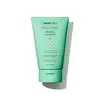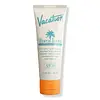What's inside
What's inside
 Key Ingredients
Key Ingredients

 Benefits
Benefits

 Concerns
Concerns

 Ingredients Side-by-side
Ingredients Side-by-side

Titanium Dioxide 2%
Cosmetic ColorantZinc Oxide 17%
Cosmetic ColorantDimethicone
EmollientCaprylic/Capric Triglyceride
MaskingDimethicone Crosspolymer
Emulsion StabilisingDimethicone/Vinyl Dimethicone Crosspolymer
Skin ConditioningButyloctyl Salicylate
Skin ConditioningGlyceryl Isostearate
EmollientPolysilicone-15
UV FilterPunica Granatum Extract
AstringentVaccinium Macrocarpon Fruit Extract
AstringentUbiquinone
AntioxidantCamellia Sinensis Leaf Extract
AntimicrobialTetrahexyldecyl Ascorbate
AntioxidantSqualane
EmollientTocopheryl Acetate
AntioxidantPolyhydroxystearic Acid
EmulsifyingSilica
AbrasiveTriethoxycaprylylsilane
CI 77891
Cosmetic ColorantCI 77491
Cosmetic ColorantCI 77492
Cosmetic ColorantCI 77499
Cosmetic ColorantTitanium Dioxide 2%, Zinc Oxide 17%, Dimethicone, Caprylic/Capric Triglyceride, Dimethicone Crosspolymer, Dimethicone/Vinyl Dimethicone Crosspolymer, Butyloctyl Salicylate, Glyceryl Isostearate, Polysilicone-15, Punica Granatum Extract, Vaccinium Macrocarpon Fruit Extract, Ubiquinone, Camellia Sinensis Leaf Extract, Tetrahexyldecyl Ascorbate, Squalane, Tocopheryl Acetate, Polyhydroxystearic Acid, Silica, Triethoxycaprylylsilane, CI 77891, CI 77491, CI 77492, CI 77499
Zinc Oxide
Cosmetic ColorantAllantoin
Skin ConditioningAloe Barbadensis Leaf Extract
EmollientButyrospermum Parkii Butter
Skin ConditioningCaprylhydroxamic Acid
Caprylic/Capric Triglyceride
MaskingCapryloyl Glycerin/Sebacic Acid Copolymer
Skin ConditioningCaprylyl Caprylate/Caprate
EmollientCaprylyl Glyceryl Ether
CleansingCucumis Sativus Fruit Extract
EmollientDicaprylyl Carbonate
EmollientDiheptyl Succinate
EmollientGalactoarabinan
Glycerin
HumectantHelianthus Annuus Extract
EmollientMagnesium Sulfate
Methyl Dihydroabietate
Niacinamide
SmoothingOryza Sativa Bran Extract
Skin ConditioningPolyglyceryl-2 Oleate
EmulsifyingPolyglyceryl-2 Stearate
EmulsifyingPolyhydroxystearic Acid
EmulsifyingPropanediol
SolventRosmarinus Officinalis Leaf Extract
AntimicrobialTocopherol
AntioxidantTriethoxycaprylylsilane
Water
Skin ConditioningZinc Oxide, Allantoin, Aloe Barbadensis Leaf Extract, Butyrospermum Parkii Butter, Caprylhydroxamic Acid, Caprylic/Capric Triglyceride, Capryloyl Glycerin/Sebacic Acid Copolymer, Caprylyl Caprylate/Caprate, Caprylyl Glyceryl Ether, Cucumis Sativus Fruit Extract, Dicaprylyl Carbonate, Diheptyl Succinate, Galactoarabinan, Glycerin, Helianthus Annuus Extract, Magnesium Sulfate, Methyl Dihydroabietate, Niacinamide, Oryza Sativa Bran Extract, Polyglyceryl-2 Oleate, Polyglyceryl-2 Stearate, Polyhydroxystearic Acid, Propanediol, Rosmarinus Officinalis Leaf Extract, Tocopherol, Triethoxycaprylylsilane, Water
 Reviews
Reviews

Ingredients Explained
These ingredients are found in both products.
Ingredients higher up in an ingredient list are typically present in a larger amount.
This ingredient is an emollient, solvent, and texture enhancer. It is considered a skin-softener by helping the skin prevent moisture loss.
It helps thicken a product's formula and makes it easier to spread by dissolving clumping compounds.
Caprylic Triglyceride is made by combining glycerin with coconut oil, forming a clear liquid.
While there is an assumption Caprylic Triglyceride can clog pores due to it being derived from coconut oil, there is no research supporting this.
Learn more about Caprylic/Capric TriglyceridePolyhydroxystearic Acid is a soft wax made from castor oil.
It is is a texture thickener, emulsifier, and film-former. Emulsifiers prevent ingredients from separating, such as oils and waters.
Polyhydroxystearic Acid may not be fungal acne safe.
Learn more about Polyhydroxystearic AcidTriethoxycaprylylsilane is a silicone used to bind and stabilize ingredients.
As an emulsifier, it helps prevent ingredients from separating. This can help elongate the shelf life of products.
Triethoxycaprylylsilane is often used to coat mineral sunscreens ingredients to help give a better feel. It also helps reduce oxidative stress in sunscreens.
Learn more about TriethoxycaprylylsilaneZinc Oxide is a mineral broad-spectrum UV filter; it is the broadest UVA and UVB reflector approved by the FDA. It also has skin protectant and skin soothing properties.
Zinc oxide is one of the most effective broad-spectrum UV filters. It protects against UVB, UVAII, and UVAI. In comparison to its counterpart titanium dioxide, zinc oxide provides uniform and extended UVA protection.
Another great benefit? This ingredient is highly photostable so it won't degrade easily under sunlight.
A common myth is that mineral UV filters are widely believed to primarily reflect UV light.
However, modern research shows titanium dioxide absorbs UV radiation like chemical filters (~95% absorption & 5% reflection).
Zinc oxide has great skin soothing properties so you'll likely find this in sunscreens formulated for sensitive skin or babies/children. It is unlikely to cause "eye sting" like other sunscreen ingredients.
Regulatory agencies consider zinc oxide to be non-toxic and safe. It has also been shown to not penetrate the skin.
Unfortunately, this ingredient does leave a visible white cast. This is why mineral sunscreens are often less cosmetically elegant than chemical or hybrid ones.
In cosmetics, zinc oxide can be found in both non-nano and nano-sized forms. The nano version is used to reduce white cast and improve the texture of sunscreen formulas.
There are ongoing concerns surrounding nano-zinc oxide's impact on marine ecosystems and whether it can be absorbed into skin.
Regarding marine ecosystems and coral reefs, there is no conclusive evidence that any form of zinc oxide (or any other sunscreen ingredients) will cause harm. The science is still developing but many consumers are keeping a close eye on this issue.
Please note, many destinations have reef-safety sunscreen rules. For instance, the U.S. Virgin Islands advises all visitors to use non-nano mineral sunscreens.
There has also been some stir about whether micronized or nano zinc oxide has potential photoxicity and absorption through the skin/lungs.
An in-vitro (done in a test tube or petri dish) study demonstrated micronized zinc oxide to have potential phototoxicity. There's no need to fret; the EU Commission's Scientific Committee on Consumer Safety has stated, "The relevance of these findings needs to be clarified by appropriate investigations in vivo." Or in other words, further studies done on living organisms are needed to prove this.
Current research shows zinc oxide nanoparticles do not penetrate intact or sunburned skin. They either remain on the surface or in the outermost layer of dead skin (stratum corneum).
Zinc oxide is one of only two classified mineral UV filters with titanium dioxide being the other one.
Fun fact: Zinc has been used throughout history as an ingredient in paint and medicine. An Indian text from 500BC is believed to list zinc oxide as a salve for open wound. The Ancient Greek physician Dioscorides has also mentioned the use of zinc as an ointment in 1AD.
Learn more about Zinc Oxide